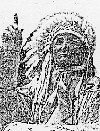 Press Review Press Review
November 4, 1937
The Okanagan Indians are an interesting people, and they're making very good progress...
By Indian Agent, James Coleman
 It is probably quite a few thousand years since the ancestors of the North American Indian reached this continent via the Bering Sea in successive waves, each wave pushing south until the pushing process was no longer effective. It is probably quite a few thousand years since the ancestors of the North American Indian reached this continent via the Bering Sea in successive waves, each wave pushing south until the pushing process was no longer effective.
There are faint indications that these early immigrants brought with them a much higher degree of civilization than was found by the first whites to reach the country and an old Okanagan legend states that the Indians had a written language but that they rather fell down on the standards required of them by their Deity and he took away their power to read and write. They also have a flood story of their own approximating the Biblical flood story and their weapons were the bow and arrow. However, it is not proposed to go into speculations regarding their early history in this article as what most concerns us is what they are doing and their future outlook.
It might be mentioned in passing that they knew of Ogopogo centuries before we thought of him, being known to them, as near as it can be pronounced, as Auchead, in much about the same way as a Scotchman would pronounce it, or literally, as "Devil Fish" which made his headquarters at the rocky point on Okanagan Lake opposite Peachland.
The last contact they had with him was a little over a hundred years ago when several canoes were returning from a party and keeping well clear of Ogopogo's lair, but one who had imbibed more of the loganberry of that time than was good for him dared to run his outboard in close and momentarily passed out of sight of his more cautious comrades, who came around the corner just in time to see his boat disappearing under the water, the wreckage being subsequently scattered along the shore.
In those days Ogopogo did not confine his activities to Okanagan Lake as he had a subterranean tunnel connecting Okanagan and Kalamalka lakes.
Some of the very oldest inhabitants of the reserve near Vernon still have a very vivid recollection of a violent earthquake of the undulating type, so severe that they could not even sit on the ground but had to lie flat until Mother Nature got over her fit.
The Okanagan Indian Agency extends from Sicamous south to the International boundary and then jumps the Richter Pass to the Similkameen and extends there from the International boundary to about twenty miles beyond Princeton and is the largest Agency in British Columbia from an acreage point of view with some 146,000 acres of Reserves of which about 14,000 acres is cultivated, half of this being under irrigation, the Indian population numbering a little over 1,000.
At present the Indian is a hay, grain and cattle farmer with logging and trapping as sidelines.
A few are beginning to feel their way into the higher branches of farming. One Indian has shipped ninety tons of canning tomatoes this fall and there are quite a few Indian orchards scattered around the agency and spraying is becoming general.
Quite a few Indians are making an enviable income from cattle, these being the discriminating individuals who know the value of good foundation stock.
The average Indian farm income in the Okanagan, and this article speaks only of the Okanagan Indian, is not high at present but sufficient to meet the average Indian standard which by the way is raising very rapidly, but a great deal of work is being done to improve farming methods and too much cannot be said for those friendly farmers employing Indians of living near Reserves who use their influence in this direction.
Indians are beginning to subscribe to farm journals and take advantage of the Government agricultural bulletins and some use has been made of the motion picture method of imparting knowledge, but there is a great deal yet to be done in teaching them the best agricultural practices.
Indians agricultural advancement, and with it his general advancement, appears to be passing through various phases. The first settlers in the Okanagan were a virile, industrious class with a high sense of honor who regarded the Indians as a valued friend and treated him accordingly resulting in his very rapid advancement and in those parts of the district when these relations have been maintained the Indians are more prosperous.
Subsequent to the War the influx of various nationalities brought in a class who were anything but desirable and often extremely radical and those Indians living near towns and having no particular contact with the old-timer class were exposed to their influences. But fortunately the majority had sense enough to appreciate the lack of character of these contacts.
It seems that we are entering another phase when the Indian having explored and tested the doubtful avenues is beginning to awaken and is now heading in the right direction. Very little examination of the question will show that the Indian is a far greater asset to the country than some of the imported riff-raff, as he is extremely loyal to the Crown, has a keen sense of justice and is very progressive considering the short time he has been in contact with what we are pleased to call "civilization" and any bad habits are mostly acquired from the whites.
Of late years there has been considerable advance in Indian health, not with standing a lot written to the contrary, and infant mortality, for instance, has been almost completely eradicated resulting in their rapid increase. They are served in the Okanagan by five doctors and four nurses who have behind them the services of various specialists for unusual cases. The children are taught health rules by Junior Red Cross organizations in the Indian schools on the Reserves and if the present profress is maintained in comparatively few years disease among Indians will be less than among the whites.
Education is receiving close attention, there being three Day Schools in the Agency, all following the curriculum of the Provincial schools on the Reserves and if the present progress is maintained in comparatively few years disease among Indians will be less than among the whites.
Education is receiving close attention, there being three Day School in the Agency, all following the curriculum of the Provincial schools. These are taken care of by Miss Katherine MacDonald at the Reserve near Vernon; Miss Elizabeth Weydert at Penticton and Anthony Walsh at Oliver. In all three a great deal of attention is given to domestic science, manual training and handicrafts in general with the basic principles of agriculture with a view to training the children to take advantage of the means of livelihood available to them rather than train them for "white collar" jobs and in the respect the Indian schools have rather led the way than merely imitated existing standards.
These teachers are in the work and stay with it because they feel that they are doing a real job and that with them lies the future of the Indian race to a very large degree. Some idea of the difficulty of their task will be realized when it is considered that with the majority of their children entering school they have no knowledge whatever of the English language and before the teacher can make any headway at all they have to give them a working knowledge of English Imagine a teacher having to go to Russia and teach a school with grades all the way from one to eight! Then again the children do not have the advantage of discussing matters of general knowledge with their parents or getting the "old man" to scratch his head over the homework, besides the problem of thinking in one language and expressing in another. Despite these handicaps the Indian children's progress is astonishing and the relations between the teacher and pupil that of a fond parent and a child. In addition to the day schools quite a few attend the large Residential those children living remote from a school. Where there is a white school near the Reserve, advantage is taken of it by arrangement with the School Board.
Agency administration covers detail of Indian life from before birth by pre-natel advice by the doctors and nurses to after death in winding up estates, and often the smaller the detail the more the fuss. Indians are subject to all the laws that pester their white brothers and in addition the "Indian Act," but have the advantage of not being subject, at present to taxation of land and personal property, but should they lease their land to a white person "Jimmy" Simms, our genial Assessor, immediately taxes it for the duration and if the land is irrigated, water dues are collected also by the Provincial Government.
Each band of Indians is entitled to appoint a Chief and Councillors, similarly to the City of Vernon with its Mayor and Councillors, this being done by the vote of the males of the band of voting age. The duties of the Council approximate those of a City Council with the difference that the Indian Council are appointed by Order-in-Council for an indefinite period and Ottawa has the right to reject unsatisfactory aspirants to office.
Regarding the future. When one considers the rapid advancement made since the arrival of the first whites there is not much worry about the future. Apart from general lack of education the greater barrier to advancement in the past generation has been the activities of worthless white agitators and unsettling advice by misguided but otherwise worthy souls who "know all about Indians".
At present every effort is being made to have the Indians work their Reserves and reduce or eliminate renting to whites. A drive has been on for some time to have every young Indian avail himself of his right to work land on the Reserve and a considerable amount of work has been done to irrigate areas not previously arable for lack of water.
It is expected that most of the remaining difficulties preventing the fulfillment of this policy will shortly be cleared away and that the next year of two will see great advancement in this respect. Work has also been done in an endeavor to improve housing conditions and many new buildings, built to modern plans but not always visible from the highways, are evidence of an awakening in this direction. The general idea is that the Indian should have a full stomach and the means whereby he can fill it, with his own labor, and that thereafter many of the now troublesome problems will vanish into thin air under the warming influence of contentment and good health incidental to proper nourishment.
While the Indian Department might achieve much in this direction despite public indifference, the shortest road to the best results will be via a return to the old-timer attitude on the part of the public, looking on the Indian as good timber in our Empire building activities, and surely there never was a time in the history of the Empire when the full co-operation of a good and loyal people -the Indians, was more urgently needed than at present.
The Indian on the Reserve is a dignified and shrewd debater as a rule and his seat in the Council of his white brothers would not be a very great disadvantage to the white brothers. May the day of mutual understanding and appreciation soon arrive.
|


